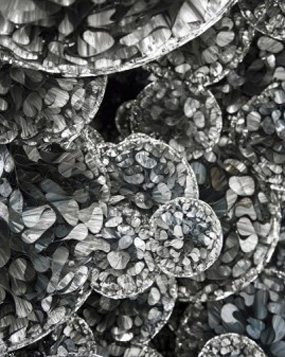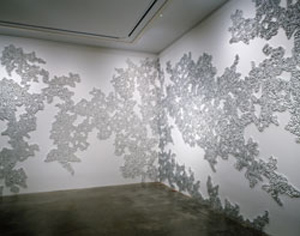Magic in Mylar
John Haberin New York City
Tara Donovan
Is it still magic if the magician gives away the trick? Tara Donovan makes her materials not exactly transparent, but at least translucent or reflective—and plain for anyone to see. The plainness is in fact the art. They shimmer nonetheless, in unpredictable ways no matter how often one comes up close or stands back. The only question is whether Donovan clings too hard to her magic.
Donovan knows how to work a room. In her case, it involves real work and a real appreciation of the room. Ordinary materials play off against an extraordinary installation, solid objects against a whole always about to come apart, and substance against light. Increasingly, the optical illusion takes over from the physical. And no question a tendency to grandeur and spectacle come with success in Chelsea. Yet the object is still there if one knows where to look. 
Making waves
In a breakthrough work, Donovan made waves. Stacked, disposable plastic cups turned a gallery floor into a lunar landscape. With her gently rolling hills of plastic, whiteness seemed itself to undulate before one's eyes. With a Bluff of shirt buttons, the whiteness seemed to grow of its own accord. It reinterprets Minimalism as an optical as much as physical experience of the surrounding space. Unlike with Minimalism, too, one could not enter that landscape, but one could never forget what one was seeing.
She was hardly alone in piling things on. The piles these days can be exhausting or annoying. They can be lessons in science class about art and optics. They can also be dark or joyful, as for Judy Pfaff, or plain funny—and it is only a short step from plastic drinking cups to Gwyneth Leech with takeout coffee cups. Artists have made a point of excess at least since Neo-Expressionism. Here, though, excess seems downright modest—and all the more surprising for it.
It would be a mistake to ask Donovan's materials to mean something specific. This is not a model landscape in a natural history museum. It does not raise challenging associations with America's social fabric as process or wasteland, like Phoebe Washburn or David Opdyke. One should not imagine a gallery opening at which the opaque plastic would serve ecologically correct wine, like the 2006 Whitney Biennial. Rather, the impulse is simultaneously domestic and formal, like the visual overflow of a dream.
One year later she appeared in "Burgeoning Geometries" at the Whitney, and one could better see the geometry beneath the burgeoning. Simple straight pins became a shining, forty-inch cube—not unlike constructions earlier in her career of rubber bands. Again she cultivated a sense of beauty and the element of surprise, but one could also better see the sense of humor, too. This was not just carnival entertainment. One had to remain aware of two very distinct scales, neither quite that of sculpture. One also had to tread carefully.
A variation on the pin cube turned up at the Flag Foundation, a curious nonprofit that, at the time, opened to the public exactly one afternoon a month. The ninth floor of the so-called Chelsea Arts Tower, otherwise a euphemism for condos, has gorgeous views. Yet even with the free catalog, one could not easily discern what was going on. One found no credits at all, beyond a consortium of anonymous private collections. Fortunately, the foundation is opening up more since then, with shows featuring the like of Jennifer Dalton. For all its quirks, too, celebrity curators like Chuck Close have been up to the task of showing off.
On a sunny day in spring, Donovan alone made the opening group show worthwhile. Her cube of wooden toothpicks had the look of polished light wood. She also made explicit a possibility in her cubic metal pincushion without the cushion—that pieces may fall off. She also embedded the cube in a slightly larger square on the floor, like a frame or a pedestal. Where does a work end and the world begin? Jacques Derrida and Constantin Brancusi asked in different ways, but here either the work or its frame could tumble off into the world.
Disco Donovan
Before long, an artist of disposable materials entered a rather nondisposible institution, the Met. The cramped museum mezzanine roughly mimics a private gallery while threatening to spill out onto the usual suspects on the floor above. Already Kara Walker and Neo Rauch have taken turns struggling with the space. Both did so by also blending artistic tradition, a nation's shameful history, and the Met's permanent collection. With Donovan, it is not so easy, for in her work history either starts with Minimalism or stretches to eternity. Would she have to close the space off entirely or open it to the skies?
She did neither. She again started small, with closed loops of Mylar tape of variable length and about the width of a thumbnail. Each loop stuck to the wall. A purely intuitive patterning ran across the entire gallery. It resembled a micrograph of microbial life, with Mylar as its cells. The museum's constraints must have obliged her to think more in terms of an image, apart from her trust in her materials.
She has done so more and more ever since. More recently in Chelsea, a single agglomeration of spheres of wildly varying dimensions takes over the gallery, in jet black corrupted by silvery reflections. A friend compared the sculpture to disco balls. I thought instead of balloon puppies or Easter bunnies by Jeff Koons spinning off to infinity. Is it a sly reference or a failing? I hardly know myself in an artist who takes on the aura of everything from household debris to museums.
 She still applies modest means to modest ends. Those ends just happen to explode across a gallery. Up close, the black, the silver, and even the spheres all but vanish. One stares instead into folded Mylar, the same material with which she worked at the Met in loops along the wall. Only she sculpts it into balls, while letting one peer into each one to relish the optical properties of the folds. Alyson Shotz does much the same with wave-forms, and her sculpture would not glow half as brightly without them.
She still applies modest means to modest ends. Those ends just happen to explode across a gallery. Up close, the black, the silver, and even the spheres all but vanish. One stares instead into folded Mylar, the same material with which she worked at the Met in loops along the wall. Only she sculpts it into balls, while letting one peer into each one to relish the optical properties of the folds. Alyson Shotz does much the same with wave-forms, and her sculpture would not glow half as brightly without them.
In another branch of Pace's empire, Donovan seems more cautious, as if in search of fine art. She calls the works drawings, although they look very much like paintings. In some, ordinary metal pins create radial patterns that, from a distance, glow with light. Others form overlapping circles, like ripples in a pond after falling stones or ripples on canvas after drips of paint. Up close the radiance subsides but the darkness brightens, in reflection of the pins. Can she still keep one on pins and needles?
The drawings come a little late in the game, after everything from the Old Masters to Vic Muniz. Drawing for centuries now has depended on small points of light and dark to create an image, perhaps in pencil, as with Georges Seurat and Seurat drawings. Something of the same spirit animates Minimalism, from the plain shapes and industrial materials of Carl Andre to the disconnect between concept and appearance in Sol LeWitt. Donovan happens to share a dealer with Close, who can create an image out of a grid of anything. That reflection on the past is part of what makes Donovan contemporary. She clings, however, harder and harder to art's magic.
The chaos of living things
For those trained in art and physics, the magic needs no explanation. Faced with another Houdini, I just want to know how it is done, like getting right to the spoilers in a mystery novel. Besides, that lets one skip over the bad prose. Like actual magic, though, with its stock of tricks, Donovan's newer work can feel mechanical, especially in the drawings. Does one really need pins as a reminder of a painter's skill? Maybe not, but do not give up on her too soon.
For one thing, Donovan still has her skill down. For another, excess here holds out real insight. For once, size hardly matters. Rather, as for Robert Therrien, scale very much does. So, as with a painter, do the materials. They are the materials of consumer culture and everyday life, too, and they leave neither one entirely behind.
For still another, she is addressing problems head on. Her work most repays attention close up, but gallery-goers could not get too near her plastic cups without a severe reprimand. One could not get too close to the Mylar tape at the Met either, although one could enjoy the variable size and form of her loops. One could pick up a pin from the floor of the Whitney at Altria, as gravity partly dissolved the cube, but with equal fear of museum propriety and the sharp point. She still wants both object and image apart from the viewer. Yet one can lean right into the spheres to break the illusion.
Donovan faces the same issues that have haunted art ever since attacks on graven images. It is just theater or spectacle, people say—substitutes for transcendence or real life. Before, she let plastic unfold into a landscape. Now the plasticity folds in on itself before expanding again before one's eyes. The lobed objects themselves suggest growth, like spores. Only this is not a parable about the society of the spectacle.
Other artists, too, have used explored the relationship between modular addition and the self-driven chaos of living things, like Andrea Zittel or Ursula von Rydingsvard. Digital art and real-time data often do. Still, you probably hated your biology textbook, and with luck you got over disco fever. You probably feel more at home with toothpicks, rubber bands, and drinking cups. When it comes down to it, so does Donovan. And then, as one peers over the spheres, they again recede into a palpable landscape.
Her materials come closest to her characteristic shimmer when the object refuses to fade away. Think back to the work with which she began. It was not just visual or physical overload. It might have sprung to life of its own accord, but it was still the work before one's eyes. Can a talented artist sustain a sense of wonder? She may not even have to try.

Tara Donovan ran at Pace through April 22, 2006, at The Metropolitan Museum of Art through April 27, 2008, and later at two Chelsea branches of Pace through March 19 and through April 9, 2011. She appeared in the inaugural exhibition of the Flag Art Foundation, curated by Chuck Close, through August 1, 2008. Her first New York solo shows were at Ace gallery.




